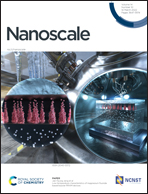Crystal structure dependent cation exchange reactions in Cu2−xS nanoparticles†
Abstract
Because of high mobility of Cu+ in crystal lattice, Cu2−xS nanoparticles (NPs) utilized as cation exchange (CE) templates to produce complicated nanomaterials has been extensively investigated. Nevertheless, the structural similarity of commonly used Cu2−xS somewhat limits the exploration of crystal structure dependent CE reactions, since it may dramatically affect the reaction dynamics and pathways. Herein, we select djurleite Cu1.94S and covellite CuS nanodisks (NDs) as starting templates and show that the crystal structure has a strong effect on their CE reactions. In the case of djurleite Cu1.94S NDs, the Cu+ was immediately substituted by Cd2+ and solid wurtzite CdS NDs were produced. At a lower reaction temperature, these NDs were partially substituted, giving rise to the formation of Janus-type Cu1.94S/CdS NDs, and this process is kinetically and thermodynamically favorable. For covellite CuS NDs, they were transformed into hollow CdS NDs under a more aggressive reaction condition due to the unique disulfide covalent bonds. These disulfide bonds distributed along [0 0 1] direction were gradually ruptured/reduced and CuS@CdS core–shell NDs could be obtained. Our findings suggest that not only the CE reaction kinetics and thermodynamics, but also the intermediates and final products are intimately correlated to the crystal structure of the host material.



 Please wait while we load your content...
Please wait while we load your content...